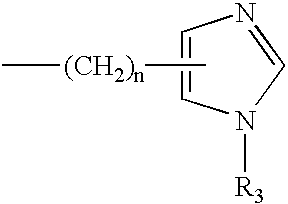Process for the preparation of 3,7-disubstituted-2,3,4,5-tetrahydro-1H-1,4-benzodiazepine compounds
a technology of tetrahydro-1,4 and tetrahydro-1, which is applied in the preparation of isocyanic acid derivatives, drug compositions, biocides, etc., can solve the problems of fptase inhibitors' pharmacokinetics, pharmacodynamics and toxicity, and the protein products of these genes are defective, so as to achieve the effect of safer and more efficient processes
- Summary
- Abstract
- Description
- Claims
- Application Information
AI Technical Summary
Benefits of technology
Problems solved by technology
Method used
Image
Examples
example 1
Preparation of (R)-3-[N-(1-Hydroxymethyl-2-phenylethyl)amino]methyl]-4-nitrobenzenecarbonitrile
[0159]
Under a nitrogen atmosphere, a solution of 5-cyano-2-nitrobenzaldehyde (2,700 g, 15.33 mol) and D-phenylalaninol (2,412 g, 15.95 mol) in dichloromethane was heated at reflux for 2 hours. After cooling the reaction mixture to 5° C., acetic acid (1,476 g, 24.58 mol) was added, followed by the portionwise addition of sodium triacetoxy borohydride (4,565 g, 85% real, 18.31 mol). The reaction mixture was warmed to room temperature and stirred at room temperature overnight, cooled to 15° C. and diluted with 1N sodium hydroxide solution (18,166 mL) while maintaining the reaction mixture temperature below 25° C. The phases were separated. The organic phase was distilled to remove dichloromethane. The pot was chased twice with tert-butyl methyl ether (2×36,360 mL). The resultant slurry was stirred overnight at 25° C., cooled to 0°–5° C., held at 5° C. for 1 hour and filtered to obtain a solid...
example 2
Preparation of (R)-N-[(5-Cyano-2-nitrophenyl)methyl]-N-[(1-hydroxymethyl)-2-phenylethyl]thiophene-2-sulfonamide
[0160]
A three-necked round bottom flask equipped with a thermocouple, a nitrogen inlet, and a mechanical stirrer was charged with (R)-3-[N-(1-hydroxymethyl-2-phenylethyl)amino]methyl]-4-nitrobenzenecarbonitrile (25 g, 0.08 moles), THF (20 ml), and N-methyl morpholine (NMM) (17.8 mL, 2.0 eq). To this mixture was added N,O-bis(trimethylsilyl)acetamide (BSA) (15 mL, 0.75 eq). The reaction mixture was stirred for 30–45 min at a temperature of 20 to 30° C.; then, a solution of 2-thienylsulfonyl chloride (23.0 g, 1.5 eq) in THF (5 mL) was added with stirring while holding the reaction mixture in the same temperature range for 8 h to 16 h until the reaction was judged to be sufficiently complete by HPLC analysis. THF (200 mL), MTBE (200 mL), and water (80 mL) were added sequentially and the reaction mixture was stirred for 10–15 min before separating the phases. The organic phase ...
example 3
Preparation of (R)-7-Cyano-2,3,4,5-tetrahydro-3-(phenylmethyl)-4-[2(1H)-thienylsulfonyl]-1H-1,4-benzodiazepine
[0161]
Benzenesulfonyl chloride (1,488 g, 8.42 mol) was slowly added to a mixture of (R)-N-[5-cyano-2-nitrophenyl)methyl]-N-[(1-hydroxymethyl)-2-phenylethyl]thiophene-2-sulfonamide (3,500 g, 7.66 mol), 4-dimethylaminopyridine (84.2 g, 0.69 mol) and triethylamine (1,085 g, 10.72 mol) in dichloromethane. The resultant reaction mixture was stirred at room temperature for 3 hours, diluted with tetrahydrofuran and cooled to 10°–15° C. A sodium dithionite solution (prepared from 6,270 g of 85% sodium dithionite and 35,000 g of water) was added to the cooled reaction mixture at such a rate as to maintain the reaction mixture temperature below 15° C. After the addition was complete, the reaction mixture was warmed to and stirred at room temperature overnight, treated with concentrated hydrochloric acid to a pH of about 1.5–2.0, and the phases were separated. The organic phase was was...
PUM
 Login to View More
Login to View More Abstract
Description
Claims
Application Information
 Login to View More
Login to View More - R&D
- Intellectual Property
- Life Sciences
- Materials
- Tech Scout
- Unparalleled Data Quality
- Higher Quality Content
- 60% Fewer Hallucinations
Browse by: Latest US Patents, China's latest patents, Technical Efficacy Thesaurus, Application Domain, Technology Topic, Popular Technical Reports.
© 2025 PatSnap. All rights reserved.Legal|Privacy policy|Modern Slavery Act Transparency Statement|Sitemap|About US| Contact US: help@patsnap.com



